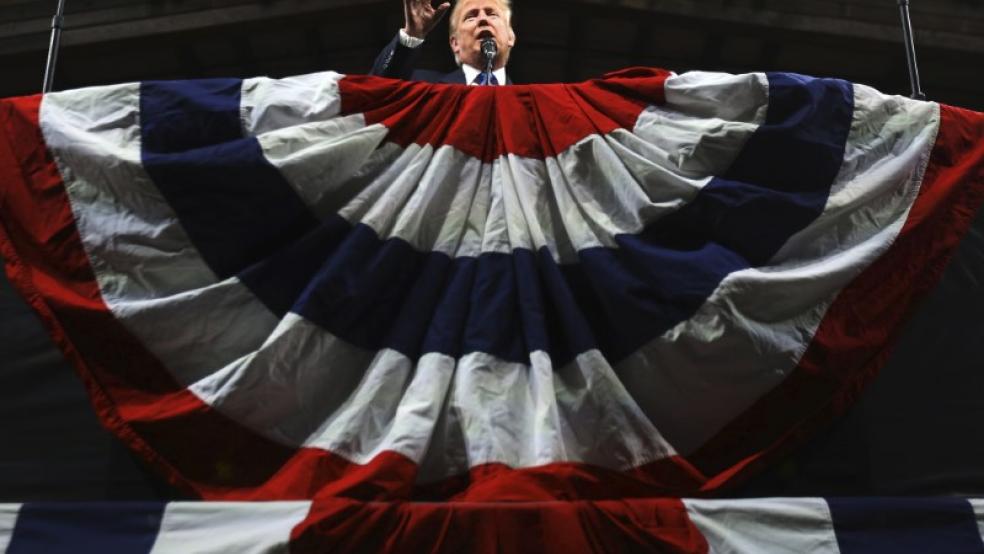A white paper released by the Donald Trump campaign on Monday claims that the Republican presidential nominee’s economic plan, which has been criticized for adding trillions to the national debt while slashing taxes for the wealthy, is nearly revenue neutral, thanks in large part to its proposed overhaul of US trade policy.
In the 31-page defense of Trump’s economic plan, University of California-Irvine economist Peter Navarro and private equity investor Wilbur Ross argue that criticism of the GOP nominee’s proposals are unfair because they do not take into account all the positive effects it will have on the economy.
Related: As Debate Looms, Paul Ryan Polishes a Participation Trophy for Trump
“In considering how to score these competing plans fiscally, it is important to note that the Trump plan generates positive and substantial tax revenue offsets from its synergistic suite of trade, regulatory, and energy policy reforms,” they write. “Any analysis that scores the Trump tax cuts in isolation is incomplete and highly misleading.”
As it turns out, the effects of Trump’s trade policies are expected to do most of the heavy lifting, adding an estimated $1.74 trillion in additional tax revenue to the US Treasury over the space of 10 years.
The problem is that when economists and international trade experts not affiliated with the Trump campaign started reading it, they were not impressed. “Nonsense,” an economist from the Tax Foundation called it. Another from the CATO Institute tweeted out the hashtag #WeAreAllDoomed. A conservative Canadian financial columnist warned a colleague not even to try reading it, saying, “you will poke your eyes out with hot spikes.”
Commentators took special exception to Navarro’s and Ross’s discussion of the nature of the country’s Gross Domestic Product and its relationship with the trade deficit.
Related: There Are Still Some Big Holes in Trump’s Plan for Economic Growth
“The growth in any nation’s gross domestic product (GDP) – and therefore its ability to create jobs and generate additional income and tax revenues – is driven by four factors: consumption growth, the growth in government spending, investment growth, and net exports. When net exports are negative, that is, when a country runs a trade deficit by importing more than it exports, this subtracts from growth.”
By simply exporting more and importing less, they argue, US businesses and workers would enjoy much healthier economic growth. However, as experts like economist Alan Cole, pointed out on Monday, the interplay between the elements of GDP is much more complicated than that. Every widget sent overseas is a widget that isn’t consumed domestically. So while sending it overseas helps bring down the negative impact of a trade imbalance, it does so by reducing the impact of domestic consumption on GDP.
To be sure, it is possible to increase the productivity of US workers, creating more widgets but there’s precious little evidence in the white paper that suggests that would suddenly occur. In fact, with the Trump plan restricting foreign competition -- as it promises to do -- claiming that US industries would respond with increased efficiency and innovation flies in the face of the laws of economics.
“There is so much wrong with it in terms of basic facts and policy,” said Scott Lincicome, a trade attorney and adjunct scholar at the libertarian Cato Institute.
Related: Clinton Ups the Ante on the Estate Tax with Her ‘Tax-the-Rich’ Plan
Lincicome seemed particularly amazed at a section of the paper in which the authors essentially promise that a Trump administration would play chicken with the World Trade Organization to force a change in Value-Added Tax policy that they believe disadvantages US exporters. (Whether or not it does is very much in question.)
The stick that Trump would be wielding in those negotiations would be a US exit from the WTO.
“Donald Trump understands that the only way to correct this unfair tax treatment is for the US to use its status as the world’s largest economy, the world’s largest consumer, and the world’s largest importer to put pressure on the WTO to change this unequal treatment,” Navarro and Ross write. “Without the US as a member, there would not be much purpose to the WTO, but prior occupants in the White House have been unwilling to lead on this issue despite its significant negative impacts.”
First, according to Lincicome, the idea that Trump could strong arm the WTO – a body where major decisions must be unanimous – is “absurd.”
While Trump might have the authority to pull the US out of the WTO, he could not unilaterally change the country’s existing tariff laws. However, said Lincicome, US withdrawal “would permit every other trading partner in the world to unilaterally block US exports, unilaterally infringe on US intellectual property.”
Beyond that, he added, “A US exit from the WTO would just crash markets. The economic uncertainty that would be unleashed by the world’s largest economy leaving a body that has been a pillar of the global economic framework since the 1940s? It would be devastating.”
This list of complaints about the Trump proposal from Lincicome and others was long, but the attorney said he managed to find one bright spot.
“There is a sliver of good news in this,” he said. “Even right now during campaign season, when politicians are at max hyperbole, we are not seeing any advocacy of the broad-based across the board tariffs that Trump has threatened to do at certain points.
“Some have argued that a president Trump actually would have the legal authority to do this kind of stuff,” Lincicome said, though he doubts it himself. At least, he added, “We’re not seeing Trump’s most protectionist trade advisors arguing for that.”
In this campaign season, that’s what passes for good news.





